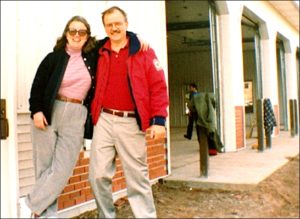From Single Van,
Cooperstown Couple Built
3-County Ambulance Service
By JIM KEVLIN

COOPERSTOWN - It began in a simpler time.
“I was in the room when Jim Dow bought the medical coach from Bassett for $1,” recalled Margaret McGown.
That was almost four decades ago, and McGown and her husband, Mark Zeek, on Jan. 8, sold what has since grown from the single van into the three-county, 12-ambulance, five-station, 95-employee Cooperstown Medical Transport.
“We’ve lived the American Dream,” she repeated in a follow-up interview after the sale of CMT, an Otsego, Delaware and Chenango county mainstay institution, to Syracuse-based AMR. (She added at another point, “We’ve WORKED the American Dream.”)
AMR (American Medical Response) will consolidate three-county CMT with its operation in Schoharie, Herkimer and Montgomery counties into a single response unit.
The husband-wife partnership that headed for retirement a week ago began in the 1960s at “The Pit,” the basement hangout at Cooperstown’s Tunnicliff Inn, where youngsters and less-young-sters would gather after a day skiing at Mount Otsego in Pierstown.
The teenagers would sit and chat with their pals – and each other – by the roaring fire, cementing their friendship over hours of conversation.
Then they went their separate ways, she to Elmira College and a master’s at Russell Sage, he to SUNY Albany, both marrying other people, both working at Bassett Hospital. By the end of the 1970s, both were single parents, and their friendship rekindled into marriage.
In 1980, a year after Margaret witnessed the $1 sale to Jim Dow, former proprietor of what’s now the Connell, Dow & Deysenroth Funeral Home, the phone rang early one morning at the McGown-Zeek home while the couple was still in bed.
Would you like to buy the van and medical-transport business for $900? “We’ll call you back,” but the answer was “yes.” Margaret obtained a loan from Key Bank “on my signature. And that’s when it started.”
They didn’t know it at the outset but, looking back, “it was very much a time when ambulance providers started speeding up,” said Mark.
“There were all these tests that became available,” Margaret added – CAT scans were just the beginning. “But not everyone had the expertise.”
You have reached your limit of 3 free articles
To Continue Reading
Our hard-copy and online publications cover the news of Otsego County by putting the community back into the newspaper. We are funded entirely by advertising and subscriptions. With your support, we continue to offer local, independent reporting that is not influenced by commercial or political ties.

